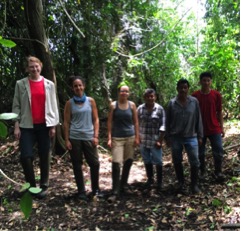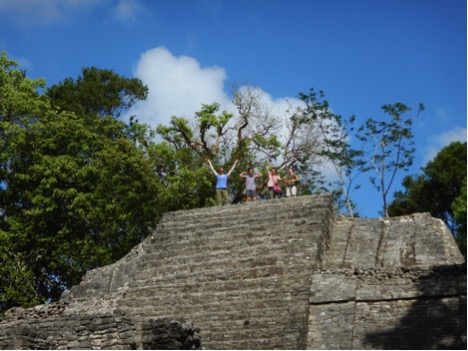Samantha M. Krause 2017 Field Report
2017 CLAG Field Study Award Report:
Samantha M. Krause, PhD Candidate: Department of Geography and the Environment, UT Austin.
Project: Wetland Agroecoystems in the Maya Lowlands: LiDAR and Multi-Proxy Environmental Change.
My research uses a combination of remote sensing techniques and geoarchaeological methods to better understand the land use history of prehistoric agroecosystems in the Maya Lowlands, a region that extends into Belize, Mexico, and Guatemala. I target understudied prehistoric agricultural wetlands using a variety of methods: survey and remote sensing, soil stratigraphy, paleoecology, carbon isotopes, elemental geochemistry, and other geoarchaeological techniques.

Students and associates at Birds of Paradise wetlands
Through this work, I am answering questions concerning the scale, environmental impact, and types of ancient indigenous wetland management compared to modern wetland management. My research explores the spatial and temporal scales of human occupation, agricultural strategies, and resource depletion within these wetland environments. Through this, I seek to provide new proxy evidence for paleoenvironmental change in these understudied tropical systems.
The first field site that I worked on for my dissertation this past summer was the ancient Maya urban center of Colha within Cobweb Swamp. I was able to collect soil samples around the site for my ongoing research on ancient Maya impacts on soils, as well as lead surveys around the swamp periphery for mapping and water quality sampling.

Geoarchaeological teams at work
The second area that I focused on for my summer research was the Birds of Paradise wetland that is in located in a watershed within the transboundary region of Belize, Mexico, and Guatemala. In 2016, a consortium of scholars that I am a part of conducted a LiDAR survey of tropical forested wetlands, including the Birds of Paradise wetland. This provided extensive new remotely sensed evidence of anthropogenically modified fluviokarst systems and wetland agricultural underneath the tropical forest canopy. Using the 2016 lidar survey data, I focused on five new portions of the Birds of Paradise system that we had not previously detected to have prehistoric impacts. I placed excavation units on an occupational surface around the fields, three units on canal/field complexes, and one unit on an anthropogenic berm that could have been used as a causeway throughout the wetland system.
All of this was made possible by the support and generosity of CLAG. Please see the full report here.

Students at the National Archaeological Park of Lamanai


















